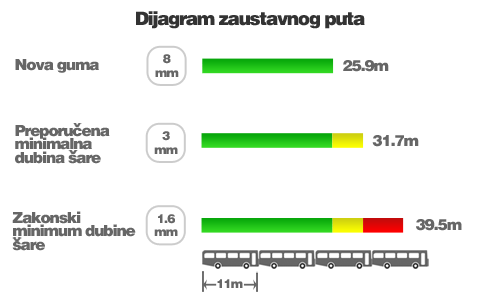As previously known, according to the new "Rulebook on the division of motor and trailer vehicles and technical conditions for vehicles in road traffic" which is applied from 4.5.2012. year in Serbia, it is stated, above all, the use of winter equipment in the period from November 1 to April 1 if there is snow or ice on the road. Winter equipment must also be present if you are moving outside the settlement, and it includes four winter car tires, whose tread depth must not be less than 4 mm (Article 113, paragraph 3 of this Ordinance) and snow chains, or other devices. to increase traction, which must be placed on at least two drive points, if they come across a part of the road where the traffic sign provides winter equipment, and weather conditions require it.
In the case of summer tires, Article 86 of this Ordinance states that the depth of the tread must be higher than the factory permitted depth marked with TWI markings, or if they do not exist, the minimum permissible depth is 1.6 mm.
Please note that the same Article of this Ordinance states that tires on the same axle must be the same according to the manufacturer, type, type (summer, winter), construction (radial, diagonal and with crossed belts), load capacity and dimensions.

When it comes to driving on wet roads, since water cannot compress and reduce its volume, a certain depth of the pattern is needed to drain the water from the contact surface. If the water does not drain quickly enough from the tread, the tires will literally float on the water film (so-called aquaplaning effect) and will be drastically less able to adhere. Therefore, it is better to change the tires when the tread depth approaches the value of 3 mm, although the law allows driving up to 1.6 mm. Tests show that a tire with a tread depth of 3mm has 25% better performance when braking on wet roads than one with a tread depth of 1.6mm. This means a full 8m shorter stopping distance when braking at a speed of 80km / h! If they compare a new tire with a tread depth of 8mm and a tire with a tread of 1.6mm, the difference in stopping distance is 13m at the same speed.
When driving on a snow-covered surface, it is recommended that you consider replacing it when the depth of the pattern is 5 mm, although the law allows 4 mm. You need a deeper pattern for the reason that the tire should first compress the snow into its grooves and then throw it out of them during turning. If the pattern is shallow, the tire will not be able to go through the snow, but will capture smaller amounts, which will reduce the grip, handling and mobility of your vehicle.